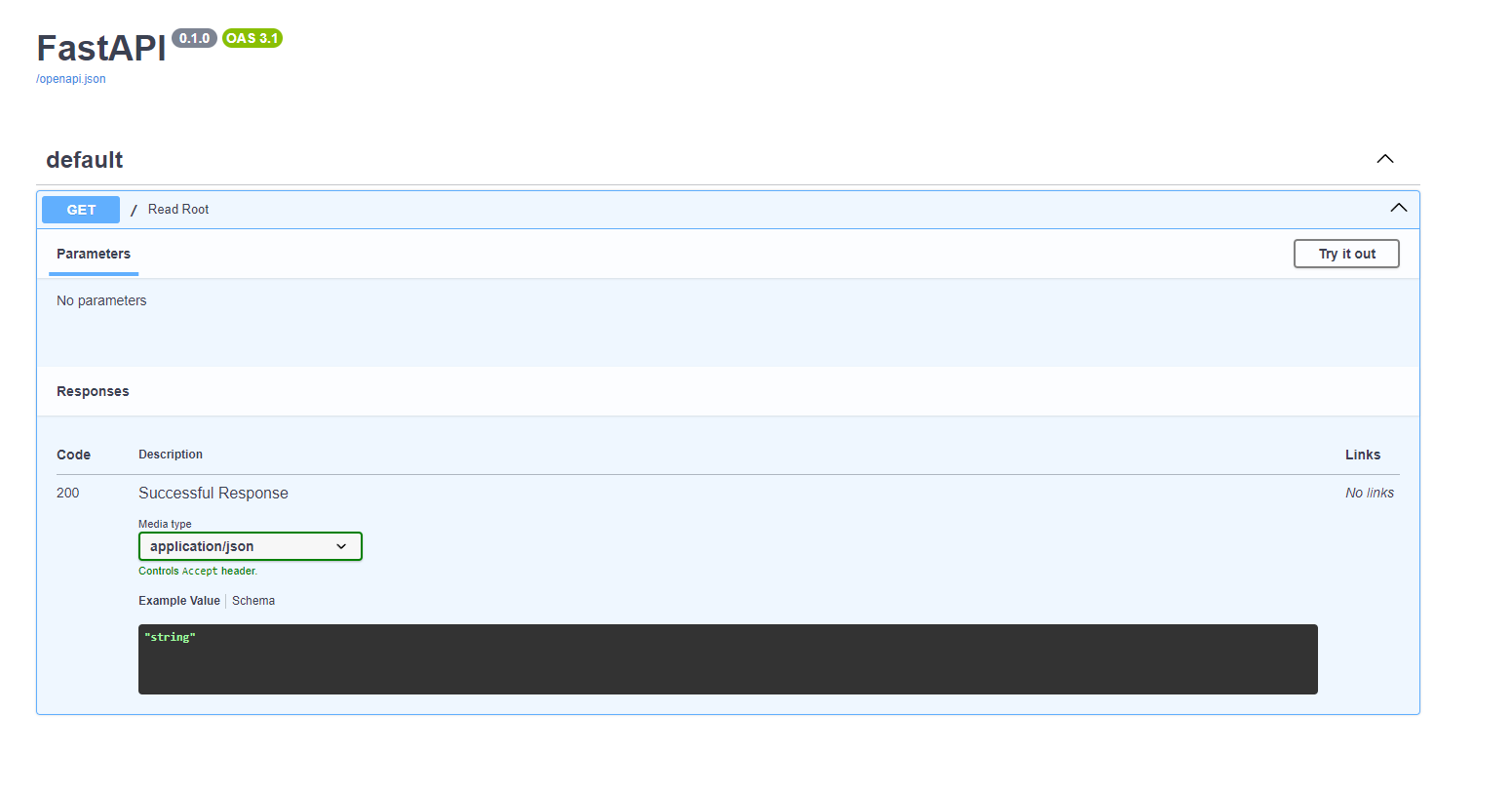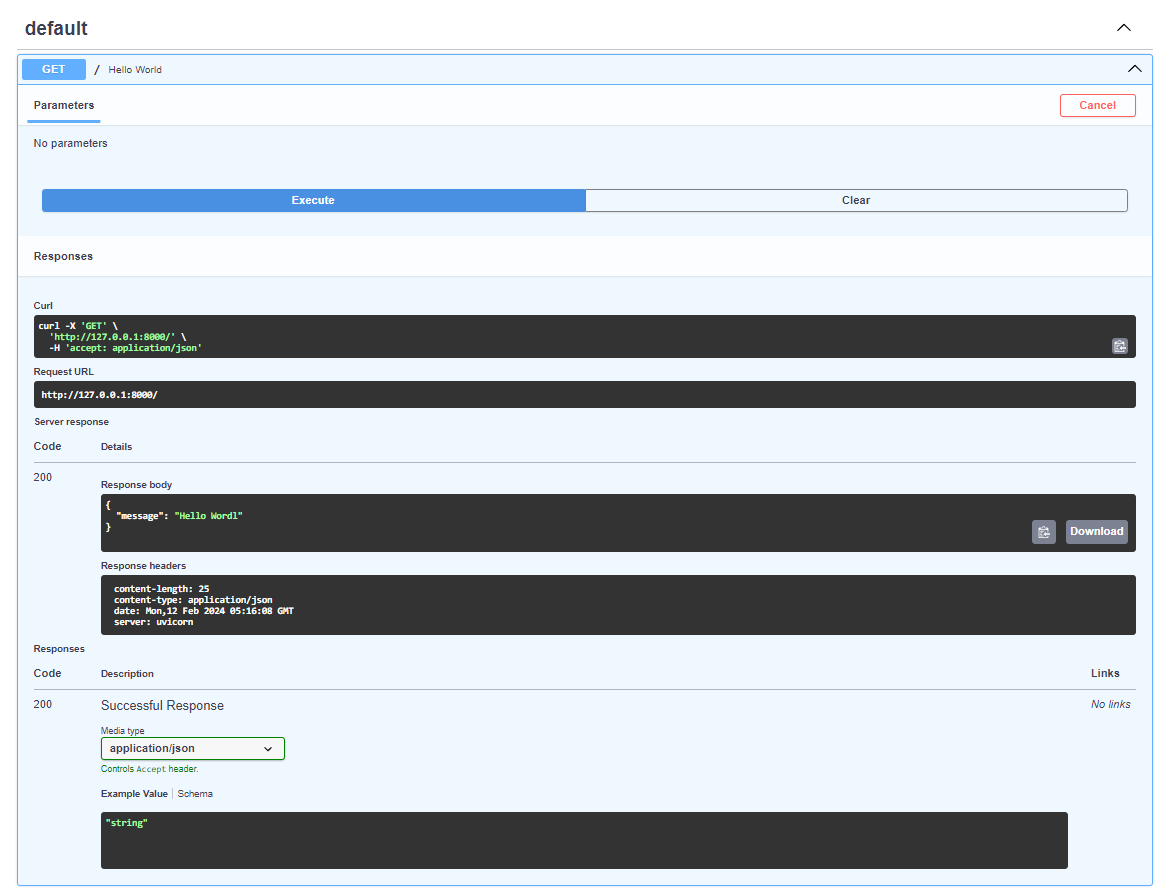برای تست اولیه fast api کافیست در پوشه پروژه خود یک فایل main.py ایجاد کرده و محتوایت زیر را قرار دهید:
from fastapi import FastAPI
app = FastAPI()
@app.get("/")
def hello_world():
return {"message": "Hello World"}
استفاده از FastAPI CLI
برای راه اندازی ساده و سریع سرویس می توانید با استفاده از رهبرد های Fastapi-cli به اجرای پروژه بپردازید که به شکل زیر خواهد بود:
fastapi dev main.py
که در نهایت خروجی زیر را در بر خواهد داشت:
INFO Using path main.py
INFO Resolved absolute path
C:\Users\Ali\Documents\GitHub\FastAPI-Tutorial-Service\core\main.py
INFO Searching for package file structure from directories with __init__.py files
INFO Importing from C:\Users\Ali\Documents\GitHub\FastAPI-Tutorial-Service\core
╭─ Python module file ─╮
│ │
│ 🐍 main.py │
│ │
╰──────────────────────╯
INFO Importing module main
INFO Found importable FastAPI app
╭─ Importable FastAPI app ─╮
│ │
│ from main import app │
│ │
╰──────────────────────────╯
INFO Using import string main:app
╭────────── FastAPI CLI - Development mode ───────────╮
│ │
│ Serving at: http://127.0.0.1:8000 │
│ │
│ API docs: http://127.0.0.1:8000/docs │
│ │
│ Running in development mode, for production use: │
│ │
│ fastapi run │
│ │
╰─────────────────────────────────────────────────────╯
INFO: Will watch for changes in these directories: ['C:\\Users\\Ali\\Documents\\GitHub\\FastAPI-Tutorial-Service\\core']
INFO: Uvicorn running on http://127.0.0.1:8000 (Press CTRL+C to quit)
INFO: Started reloader process [11252] using WatchFiles
INFO: Started server process [10076]
TP/1.1" 200 OK
استفاده از Uvicorn
برای راه اندازی سرور و دسترسی به اپلیکیشن کافیست در پوشه پروژه و جایی که فایل main قرار دارد در ترمینال خود دستور زیر را وارد نمایید:
uvicorn main:app --reload
با این کار اپلیکیشن شما در حالت اجرا و در وضعیت پوش کردن به تغییرات می ماند و با هر بار تغییر در کد و ذخیره سازی آن سرور به صورت خودکار باز نشانی خواهد شد.
می توانید تمام آپشن های اجرایی uvicorn را در زیر مشاهده نمایید:
$ uvicorn --help
Usage: uvicorn [OPTIONS] APP
Options:
--host TEXT Bind socket to this host. [default:
127.0.0.1]
--port INTEGER Bind socket to this port. If 0, an available
port will be picked. [default: 8000]
--uds TEXT Bind to a UNIX domain socket.
--fd INTEGER Bind to socket from this file descriptor.
--reload Enable auto-reload.
--reload-dir PATH Set reload directories explicitly, instead
of using the current working directory.
--reload-include TEXT Set glob patterns to include while watching
for files. Includes '*.py' by default; these
defaults can be overridden with `--reload-
exclude`. This option has no effect unless
watchfiles is installed.
--reload-exclude TEXT Set glob patterns to exclude while watching
for files. Includes '.*, .py[cod], .sw.*,
~*' by default; these defaults can be
overridden with `--reload-include`. This
option has no effect unless watchfiles is
installed.
--reload-delay FLOAT Delay between previous and next check if
application needs to be. Defaults to 0.25s.
[default: 0.25]
--workers INTEGER Number of worker processes. Defaults to the
$WEB_CONCURRENCY environment variable if
available, or 1. Not valid with --reload.
--loop [auto|asyncio|uvloop] Event loop implementation. [default: auto]
--http [auto|h11|httptools] HTTP protocol implementation. [default:
auto]
--ws [auto|none|websockets|wsproto]
WebSocket protocol implementation.
[default: auto]
--ws-max-size INTEGER WebSocket max size message in bytes
[default: 16777216]
--ws-max-queue INTEGER The maximum length of the WebSocket message
queue. [default: 32]
--ws-ping-interval FLOAT WebSocket ping interval in seconds.
[default: 20.0]
--ws-ping-timeout FLOAT WebSocket ping timeout in seconds.
[default: 20.0]
--ws-per-message-deflate BOOLEAN
WebSocket per-message-deflate compression
[default: True]
--lifespan [auto|on|off] Lifespan implementation. [default: auto]
--interface [auto|asgi3|asgi2|wsgi]
Select ASGI3, ASGI2, or WSGI as the
application interface. [default: auto]
--env-file PATH Environment configuration file.
--log-config PATH Logging configuration file. Supported
formats: .ini, .json, .yaml.
--log-level [critical|error|warning|info|debug|trace]
Log level. [default: info]
--access-log / --no-access-log Enable/Disable access log.
--use-colors / --no-use-colors Enable/Disable colorized logging.
--proxy-headers / --no-proxy-headers
Enable/Disable X-Forwarded-Proto,
X-Forwarded-For, X-Forwarded-Port to
populate remote address info.
--server-header / --no-server-header
Enable/Disable default Server header.
--date-header / --no-date-header
Enable/Disable default Date header.
--forwarded-allow-ips TEXT Comma separated list of IPs to trust with
proxy headers. Defaults to the
$FORWARDED_ALLOW_IPS environment variable if
available, or '127.0.0.1'.
--root-path TEXT Set the ASGI 'root_path' for applications
submounted below a given URL path.
--limit-concurrency INTEGER Maximum number of concurrent connections or
tasks to allow, before issuing HTTP 503
responses.
--backlog INTEGER Maximum number of connections to hold in
backlog
--limit-max-requests INTEGER Maximum number of requests to service before
terminating the process.
--timeout-keep-alive INTEGER Close Keep-Alive connections if no new data
is received within this timeout. [default:
5]
--timeout-graceful-shutdown INTEGER
Maximum number of seconds to wait for
graceful shutdown.
--ssl-keyfile TEXT SSL key file
--ssl-certfile TEXT SSL certificate file
--ssl-keyfile-password TEXT SSL keyfile password
--ssl-version INTEGER SSL version to use (see stdlib ssl module's)
[default: 17]
--ssl-cert-reqs INTEGER Whether client certificate is required (see
stdlib ssl module's) [default: 0]
--ssl-ca-certs TEXT CA certificates file
--ssl-ciphers TEXT Ciphers to use (see stdlib ssl module's)
[default: TLSv1]
--header TEXT Specify custom default HTTP response headers
as a Name:Value pair
--version Display the uvicorn version and exit.
--app-dir TEXT Look for APP in the specified directory, by
adding this to the PYTHONPATH. Defaults to
the current working directory.
--h11-max-incomplete-event-size INTEGER
For h11, the maximum number of bytes to
buffer of an incomplete event.
--factory Treat APP as an application factory, i.e. a
() -> <ASGI app> callable.
--help Show this message and exit.
در صورتی که مایل به اجرای سرور از داخل کد هستید می توانید به روش زیر عمل کنین
import uvicorn
if __name__ == "__main__":
uvicorn.run("main:app", port=8000, log_level="info")
در نهایت با خروجی زیر رو به رو خواهید شد:
$ uvicorn main:app --reload
INFO: Will watch for changes in these directories: ['C:\\Users\\Ali\\Desktop\\fastapi-tutorial']
INFO: Uvicorn running on http://127.0.0.1:8000 (Press CTRL+C to quit)
INFO: Started reloader process [34368] using WatchFiles
INFO: Started server process [31124]
INFO: Waiting for application startup.
INFO: Application startup complete.
INFO: 127.0.0.1:54082 - "GET / HTTP/1.1" 200 OK
از ویژگی های منحصر به فرد fastapi ایجاد داکیومنت خودکار مبتنی بر open api 3 و swagger است که می توانید همیشه از آدرس زیر به آن دسترسی داشته باشید:
http://127.0.0.1:8000/docs
پس از ورود به این آدرس با صفحه زیر مواجه خواهید شد که لیستی از تمام endpoint ها و آدرس هایی که ایجاد خواهید کرد را در آن مشاهده می کنید

در هر مرحله شما می توانید برای تست عملکرد هر endpoint ابتدا آن را در وضعیت tryout قرار دهید
و سپس با execute کردن عملکرد متناسب با endpoint مربوطه را تست نمایید.
